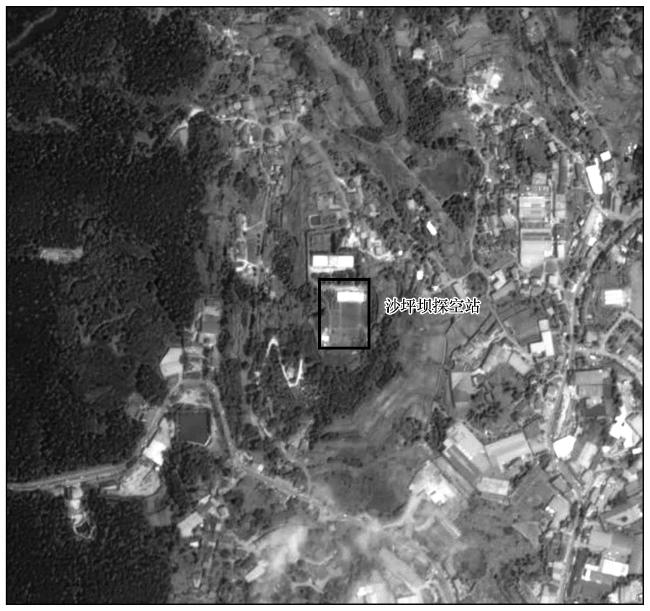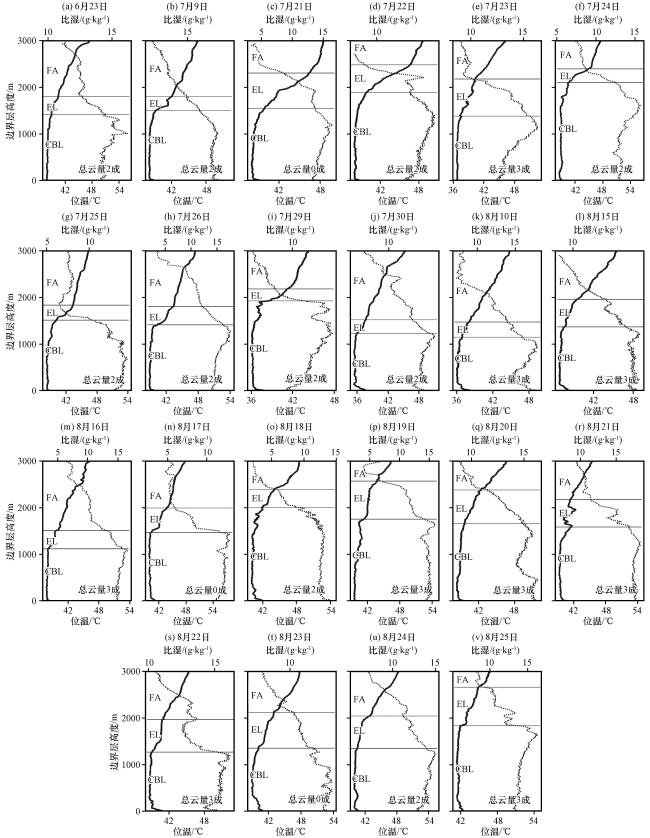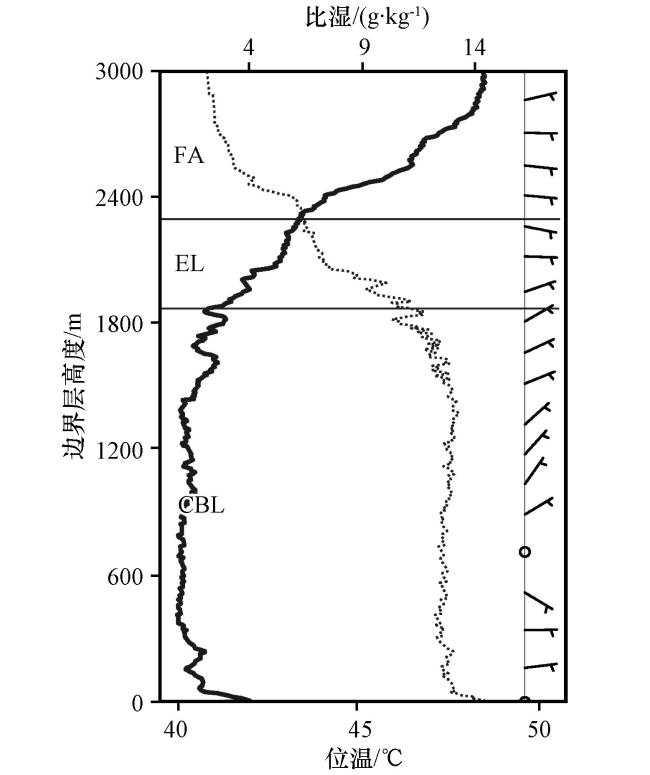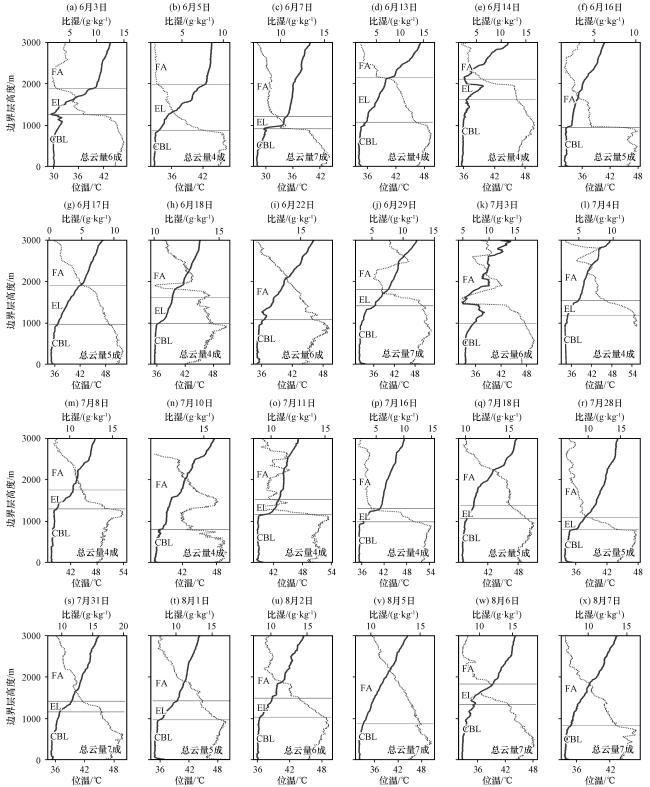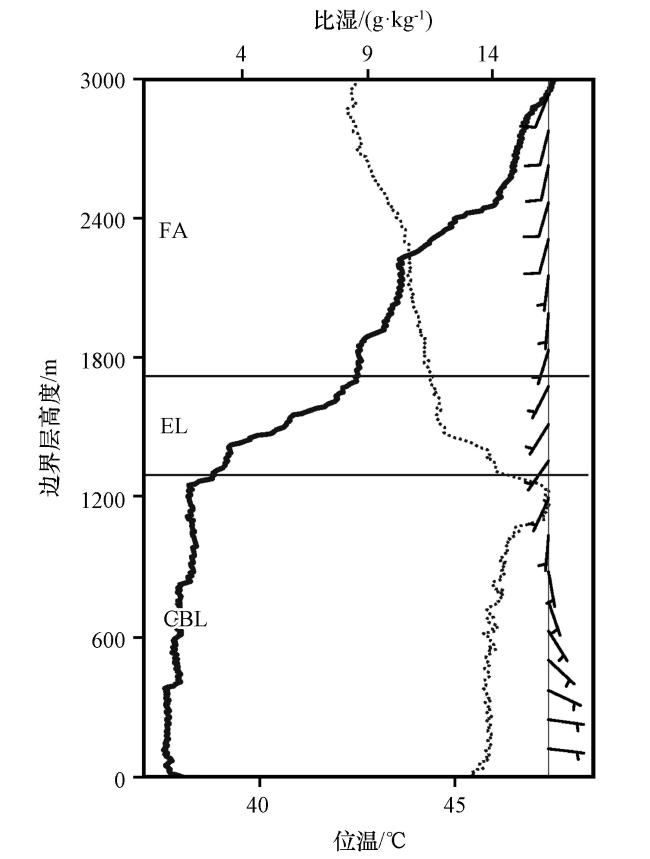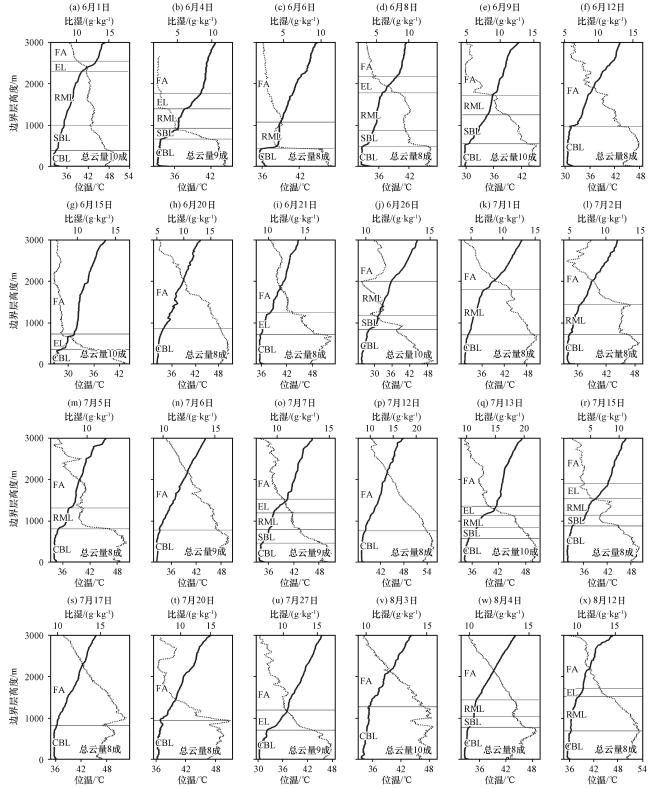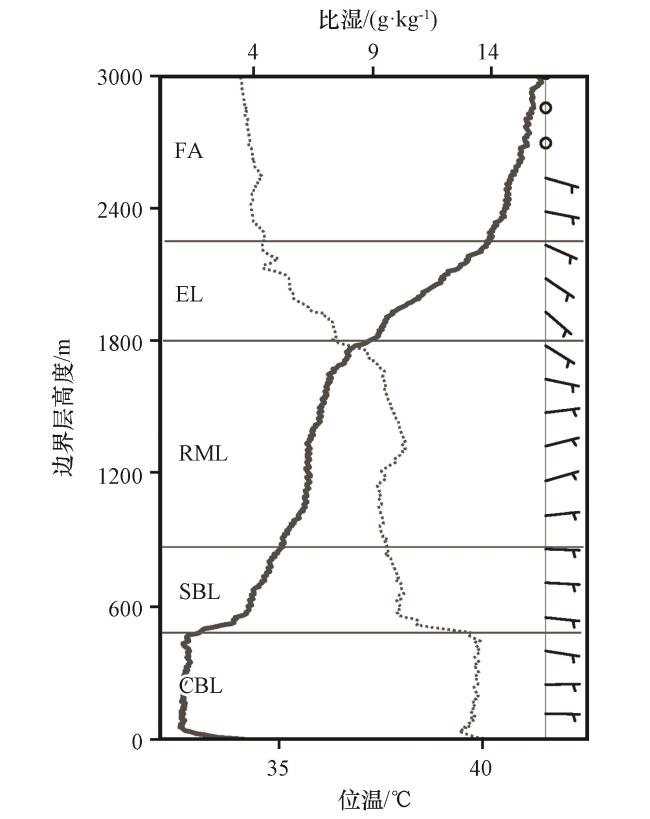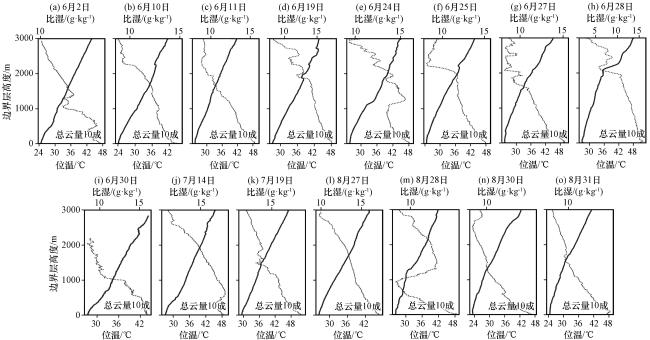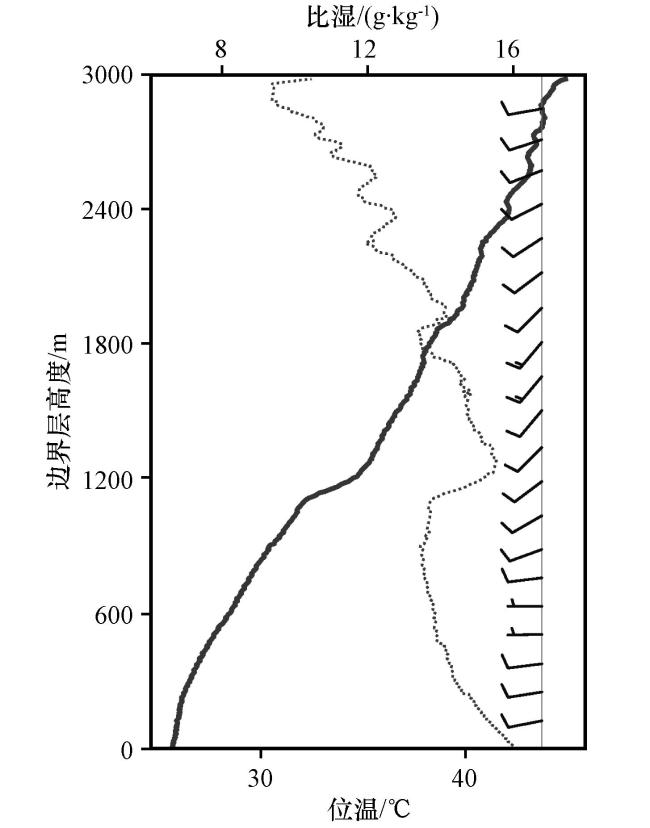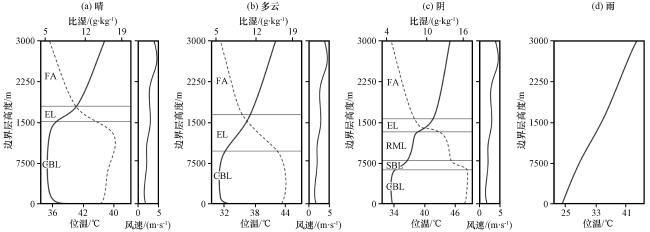1 引言
2 资料来源和方法介绍
表1 L波段探空雷达主要技术参数Table 1 Main technical parameters of L-band sounding radar |
| 技术参数 | 描述 |
|---|---|
| 雷达型号 | GFE(L)1型二次侧风雷达 |
| 测量精度 | 当风速≤10.0 m‧s-1时, 风向误差≤5.0°; 当风速10.0 m‧s-1时, 风向误差≤2.5°。 当风速≤10.0 m‧s-1时, 风速误差≤1.0 m‧s-1; 当风速10.0 m‧s-1时, 风速相对误差≤10% |
| 探测高度 | 最低探测高度: 近地面0 m; 最高探测高度: ≥5.5 km |
| 气球升速 | 400 m‧min-1 |
| 测风原理 | 属Lagrangian测量, 在不同时间对不同高度和地点进行探测 |
表2 重庆夏季午后天气条件类别划分标准Table 2 Classification criterion of weather conditions in Chongqing on summer afternoon |
| 标准 | 天气类别 | |
|---|---|---|
| 12:00-14:00累计降水量P/mm | 14:00总云量C/成 | |
| P=0.0 | 0≤C≤3 | 晴 |
| P=0.0 | 4≤C≤7 | 多云 |
| P=0.0 | 8≤C≤10 | 阴 |
| P≥0.1 | - | 雨 |
-表示无数据(-indicates no data available) |
3 不同天气条件下的大气边界层特征
3.1 晴朗条件下大气边界层特征
图2 2016年重庆夏季午后天气条件为“晴”时大气边界层位温(黑色实线, 单位: ℃)及比湿(黑色虚线, 单位: g‧kg-1)廓线标志“CBL” “EL”和“FA”分别表示大气边界层的对流边界层、 夹卷层和自由大气, 灰色横线为大气边界层不同层次分界线 Fig.2 The profiles of potential temperature (black solid line, unit: ℃) and specific humidity (black dashed line, unit: g‧kg-1) in Chongqing at summer afternoon in 2016 under the weather condition of ‘clear’.The symbols ‘CBL’ ‘EL’ and ‘FA’ represent the convective boundary layer, entrainment zone and free atmosphere, respectively, and the horizontal grey lines depict the boundaries of different layers |
表3 不同天气条件下大气边界层高度Table 3 The height of atmospheric boundary layer under different weather conditions |
| 天气类别 | 平均高度/km | 最大高度/km |
|---|---|---|
| 晴 | 1.5 | 2.1 |
| 多云 | 1.0 | 1.8 |
| 阴 | 0.6 | 1.2 |
| 雨 | - | - |
-表示无数据(-indicates no data available) |
图3 2016年8月18日大气边界层位温(黑色实线, 单位: ℃)、 比湿(黑色虚线, 单位: g‧kg-1)和风场(黑色风向杆, 单位: m‧s-1; 短线代表5 m‧s-1)廓线标志“CBL” “EL”和“FA”分别表示大气边界层的对流边界层、 夹卷层和自由大气, 灰色横线为大气边界层不同层次的分界线 Fig.3 The profiles of potential temperature (black solid line, unit: ℃), specific humidity (black dashed line, unit: g‧kg-1) and winds (black barbs, unit: m‧s-1; half barb denotes 5 m‧s-1) on August 18, 2016.The symbols ‘CBL’ ‘EL’ and ‘FA’ represent the convective boundary layer, entrainment zone and free atmosphere, respectively, and the horizontal grey lines depict the boundaries of different layers |
3.2 多云条件下大气边界层特征
图4 2016年重庆夏季午后天气条件为“多云”时大气边界层位温(黑色实线, 单位: ℃)及比湿(黑色虚线, 单位: g‧kg-1)廓线标志“CBL” “EL”和“FA”分别表示大气边界层的对流边界层、 夹卷层和自由大气, 灰色横线为大气边界层不同层次的分界线 Fig.4 The profiles of potential temperature (black solid line, unit: ℃) and specific humidity (black dashed line, unit: g‧kg-1) in Chongqing on summer afternoon in 2016 under the weather condition of ‘cloudy’.The symbols ‘CBL’ ‘EL’ and ‘FA’ represent the convective boundary layer, entrainment zone and free atmosphere, respectively, and the horizontal grey lines depict the boundaries of different layers |
图5 2016年7月8日大气边界层位温(黑色实线, 单位: ℃)、 比湿(黑色虚线, 单位: g‧kg-1)和风场(黑色风向杆, 单位: m‧s-1; 短线代表5 m‧s-1)廓线标志“CBL” “EL”和“FA”分别表示大气边界层的对流边界层、 夹卷层和自由大气, 灰色横线为大气边界层不同层次的分界线 Fig.5 The profiles of potential temperature (black solid line, unit: ℃), specific humidity (black dashed line, unit: g‧kg-1) and winds (black barbs, unit: m‧s-1; half barb denotes 5 m‧s-1) on July 8, 2016.The symbols ‘CBL’ ‘EL’ and ‘FA’ represent the convective boundary layer, entrainment zone and free atmosphere, respectively, and the horizontal grey lines depict the boundaries of different layers |
3.3 阴天条件下大气边界层特征
图6 2016年重庆夏季午后天气条件为“阴”时大气边界层位温(黑色实线, 单位: ℃)及比湿(黑色虚线, 单位: g‧kg-1)廓线标志“CBL” “SBL” “RML” “EL”和“FA”分别表示大气边界层的对流边界层、 稳定边界层、 残余混合层、 夹卷层和自由大气, 灰色横线为大气边界层不同层次的分界线 Fig.6 The profiles of potential temperature (black solid line, unit: ℃) and specific humidity (black dashed line, unit: g‧kg-1) in Chongqing at summer afternoon in 2016 under the weather condition of ‘overcast’.The symbols‘CBL’ ‘SBL’ ‘RML’ ‘EL’ and ‘FA’ represent the convective boundary layer, stable boundary layer, residual mixed layer, entrainment zone and free atmosphere, respectively, and the horizontal grey lines depict the boundaries of different layers |
图7 2016年6月8日大气边界层位温(黑色实线, 单位: ℃)、 比湿(黑色虚线, 单位: g‧kg-1)和风场(黑色风向杆, 单位: m‧s-1; 短线代表5 m‧s-1)廓线标志“CBL” “SBL” “RML” “EL”和“FA”分别表示大气边界层的对流边界层、 稳定边界层、 残余混合层、 夹卷层和自由大气 Fig.7 The profiles of potential temperature (black solid line, unit: ℃), specific humidity (black dashed line, unit: g‧kg-1) and winds (black barbs, unit: m‧s-1; half barb denotes 5 m‧s-1) on June 8, 2016.The symbols ‘CBL’ ‘SBL’ ‘RML’ ‘EL’ and ‘FA’ represent the convective boundary layer, stable boundary layer, residual mixed layer, entrainment zone and free atmosphere, respectively, and the horizontal grey lines depict the boundaries of different layers |
3.4 降水条件下大气边界层特征
图9 2016年6月24日大气边界层位温(黑色实线, 单位: ℃)、 比湿(黑色虚线, 单位: g‧kg-1)和风场(黑色风向杆, 单位: m‧s-1; 短线代表5 m‧s-1)廓线Fig.9 The profiles of potential temperature (black solid line, unit: ℃), specific humidity (black dashed line, unit: g‧kg-1) and winds (black barbs, unit: m‧s-1; half barb denotes 5 m‧s-1) on June 24, 2016 |
3.5 不同天气条件下大气边界层的一般特征
图10 夏季午后“晴”(a)、 “多云”(b)、 “阴”(c)、 “雨”(d)等不同天气背景下重庆大气边界层垂直结构的一般特征(a~c)中左侧黑色实线和黑色虚线分别表示位温(单位: ℃)和比湿(单位: g‧kg-1), 标志“CBL” “SBL” “RML” “EL”和“FA”分别表示大气边界层的对流边界层、 稳定边界层、 残余混合层、 夹卷层和自由大气, 灰色横线为大气边界层不同层次的分界线; (a~c)中右侧黑色实线表示风速(单位: m‧s-1); (d)中黑色实线表示位温(单位: ℃) Fig.10 General features of atmospheric boundary layer structure in Chongqing under different weather background of ‘clear’(a), ‘cloudy’ (b), ‘overcast’(c) and ‘rainy’ (d) on summer afternoon.Black solid lines and dashed lines in left panels in (a-c) depict potential temperature (unit: ℃) and specific humidity (unit: g‧kg-1), and the symbols ‘CBL’ ‘SBL’ ‘RML’ ‘EL’ and ‘FA’ represent the convective boundary layer, stable boundary layer, residual mixed layer, entrainment zone and free atmosphere, respectively, and the horizontal grey lines depict the boundaries of different layers.The solid lines in right panels in (a-c) depict the wind speed (unit: m‧s-1).The black solid line in (d) depicts the potential temperature (unit: ℃) |


